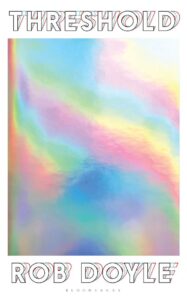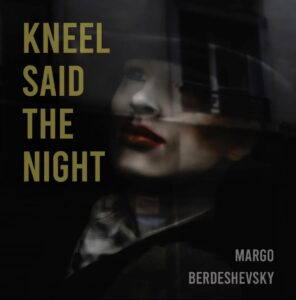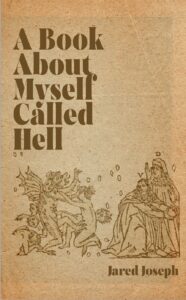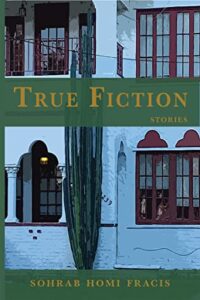Fiction. 336 pgs. Bloomsbury Publishing. January 2020. 9781635574142.
Rob Doyle’s autobiographical novel, Threshold, is made up of loosely connected chapters taking place everywhere from Berlin, to Bangkok to San Francisco, where Rob does drugs ranging from DMT, to LSD to psilocybin. (I’ll be using the writer Rob Doyle and his narrator, also named Rob Doyle, interchangeably.) Doyle’s frequently on de facto literary pilgrimages, following in the footsteps of his (often controversial) idols such as Emil Cioran, Georges Bataille, and Roberto Bolaño. He’s also working on writing projects, or attending Avant Garde art instillations, or describing sexual experiences in disarmingly lurid detail, such as one particularly memorable scene in the bathroom of a Berlin nightclub. This is a confusing, haunting, and often disturbing novel. It’s also incredibly funny – albeit bleakly funny: “I could not shoot my skull because I didn’t live in a country where I could acquire a gun,” says Doyle, musing on how he would kill himself. “The only country I knew where I’d be able to buy a gun was America,” he continues, “and I could never live there again: I would rather kill myself.”
Threshold is much more interested in provocation than pacification. Read it at your own risk: you’ll leave it feeling as disoriented as ever, which seems to be wholly intentional. “My friend Paul likes to say of his intentions as a painter: not to solve the mystery, but to deepen it.” Doyle includes this in one of the italicized interludes situated in between each chapter, and it seems to be the closest thing the novel has to any connective tissue. According to Doyle, art isn’t supposed to make sense of things. It should actually be doing the opposite.
That kind of thinking can undoubtedly be interpreted as some half-baked justification for never really settling on a point. Doyle wrote a far-reaching novel with a geographically and thematically broad scope, and can justify its lack of narrative cohesion by arguing that good art isn’t supposed to cohere into anything.
But if we are to indulge Doyle, and follow him down his rabbit hole, maybe there’s a method to the madness, as Doyle’s approach is refreshing in how it disrupts the contemporary status quo of hyper-woke works of sociopolitical commentary disguised as novels. “I couldn’t let go of my resentment at contemporary art for allowing itself to become a festival of piety and earnest political sighs,” says Doyle. Such work left him craving art “whose only dictate was hostility to the notion that art should ameliorate, edify, mould better citizens.”
I don’t know if I agree with Doyle. Do I think art can save the world? Probably not. Does that mean art should turn its back on the climate crisis and wealthy inequality and everything else destroying the world? Probably not. I also think Rob Doyle – a heterosexual white man who’s read too much Nietzsche – probably isn’t the person who should be adjudicating these issues. (Same goes for me, also a straight white man, although I probably haven’t read enough Nietzsche.) But amidst the contemporary proliferation of politically-conscious fiction, Doyle’s work stands alone in how it pays zero mind to justifying its own existence, which seems to be the driving force behind a lot of contemporary art (i.e., it exists to explain why it should exist). “Under the reign of conceptualism,” says Doyle, it’s not enough to “produce art.” You need to be able to “articulate precisely why” you made it. He refers to modern-day artists as “philosophers, academics, theorists in drag, auto-critics.” None of these are pejorative, necessarily, but none of them are artists, either.
This conceptualist framework Doyle describes as pervading contemporary art brings to mind the often-cited queen of millennial fiction: Sally Rooney. Reviewers love mentioning Rooney’s Marxist leanings, and the New Yorker famously christened her the “first great millennial novelist” for her stories of “love and late capitalism.” Rooney picked up where she left off in her most recent novel, Beautiful World, Where Are You. Like all Rooney fiction, Beautiful World is about romance, class, and the fluidity of sexual orientations and relationship dynamics. (Also like all Rooney fiction, it’s often very good.) Beautiful World is, in part, epistolary, featuring an ongoing email correspondence between the two main characters, Eileen and Alice. Here’s where Rooney loses me. Her first two novels, Conversations with Friends and Normal People, include plenty of precocious college students who are more than happy to share their musings on class, capitalism and literature. But their comments are often offhand, more in service of the story or speaking to a particular relationship dynamic than they are entities unto themselves. The epistolary elements in Beautiful World expand upon Rooney’s previously moderate – if not necessarily subtle – sociopolitical commentary. Eileen and Alice talk about the environmental catastrophe, and capitalism, and the rise of fascism. Some of their conversations are marginally applicable to the story, as Alice is in the midst of an inter-class relationship with (GASP!) a warehouse worker. But, more than anything, Rooney seems to be answering the question seemingly all novelists feel compelled to answer these days: why do novels matter when the world is ending?
Rooney’s popularity and marketability make her a trend-setter, but she is by no means alone in baking wokeness into a novel’s premise. Seemingly all contemporary fiction is set against the “backdrop” of some political, social, or cultural issue: environmental collapse; alt-right normalization; wealth inequality; and on and on. Do we need that in all of our art? Do we need that in all of our fiction? We have think pieces and podcasts and cable shows and twitter threads. It’s not a question of whether or not we need to be made aware of these issues – we do! – as much as it is a question of whether or not we need our artists to sanctimoniously shove it down our throats while every other sphere of contemporary existence is also shoving it down our throats. We need something else from our fiction. We need to be repulsed, and disoriented, and offended, and terrified, and confused, and a whole bunch of other things we don’t get from Pod Save America. We’re slowly being conditioned to evaluate our art based on the efficacy of its political statement. That’s reductive, not to mention boring.
Doyle rails against exactly this – political statement-driven artwork – while wandering through an art exhibition in Paris, where he spends more time reading the text on the plaque beside the work than he does looking at the work itself. “I was happy to leave it at that,” says Doyle, “the work itself adding nothing besides a sense of the disparity between what the text on the plaque told me I was supposed to think and feel, and what the artwork actually provoked me to think and feel, which was often nothing.” Even though he does concede that some of the texts and concepts were “quite stimulating,” there’s an emptiness Doyle’s describing; a certain apathy that comes from evaluating art on concrete, definitive terms. Maybe we shouldn’t be expecting answers from our art. Should we be expecting anything from our art?
There’s certainly no shortage of drugs in Threshold, but, in the final chapter, Doyle saves the best for last: DMT. An extremely powerful hallucinogenic famously championed by controversial ethnobotanist Terence McKenna, DMT is known as “The Spirit Molecule” for its mystical psychedelic abilities. In a book that loves to talk about drugs, DMT is a logical endpoint due to its sheer hallucinogenic power. Reading about the drug and Doyle’s experience on it is worth the price of admission in itself. But it’s also an appropriately disorienting endpoint for Doyle in that, in a novel full of unresolved mysteries, you’re left pondering one of the most mysterious substances on the planet. Doyle quotes Terence McKenna on the subject of DMT in the final chapter, who said that the drug opens you up to the “’possibility that everything you know is wrong.’” DMT, like Threshold, does nothing to solve the mystery. It deepens it.
Threshold is available through Bloomsbury Publishing. Purchase it now through their website.
Like what you’re reading?
Get new stories or poetry sent to your inbox. Drop your email below to start >>>
NEW book release
Ghosts Caught on Film by Barrett Bowlin. Order the book of which Dan Chaon calls “a thrilling first collection that marks a beginning for a major talent.”
GET THE BOOK



